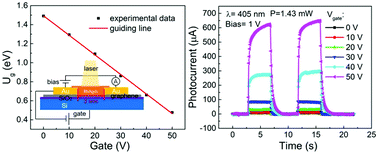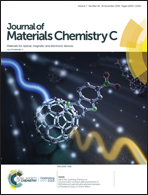Gate-tunable ion–electron hybrid phototransistor based on a graphene/RbAg4I5 composite†
Abstract
A new kind of phototransistor based on graphene and a superionic conductor is fabricated by depositing a layer of RbAg4I5 on transferred graphene by a vacuum thermal evaporation method. Electrons in graphene and silver ions in RbAg4I5 form an ion–electron bound state (IEBS) at the interface due to Coulomb interactions. The bound state, which can be dissociated by photons, greatly influences the electronic conductivity of graphene. The binding energy between ions and electrons is an important parameter to determine the photon energy that can be absorbed to set the free bound state. Through the back-gate bias, we realize controllable modulation of binding energy. The binding energy between electrons and silver ions linearly decreases with the increase of gate voltage, resulting in the increased number of IEBSs that can be dissociated by photons, which is proved by experimental measurement and theoretical analysis. Owing to the decrease in binding energy, the response amplitudes can be increased by up to two orders of magnitude under the illumination of lasers. This phototransistor based on graphene and RbAg4I5 achieves controllable responsivity from several mA W−1 to several hundred mA W−1 while the response speed remains unchanged on the order of 100 milliseconds. This study, on the one hand, gives a better understanding of the modulation of ions on electron transport; on the other hand, it offers a new road for us to achieve modulation of photo-responses, and it is very promising to be applied in optoelectronic devices with current circuit technology.



 Please wait while we load your content...
Please wait while we load your content...